The South Korean K30 Biho ("Flying Tiger") is a twin 30 mm self-propelled anti-aircraft gun (SPAAG) developed to meet SK army operational requirements for a highly mobile, short range air defense system adapted to local conditions. Its guns are electro-optically by a surveillance radar system. The vehicle is mounted on a K200 chassis shared by the K-SAM Chunma and is supposed to complement the more numerous K263A1 Chungung Vulcan. 176 were delivered by Hanwha Defense from 1999.
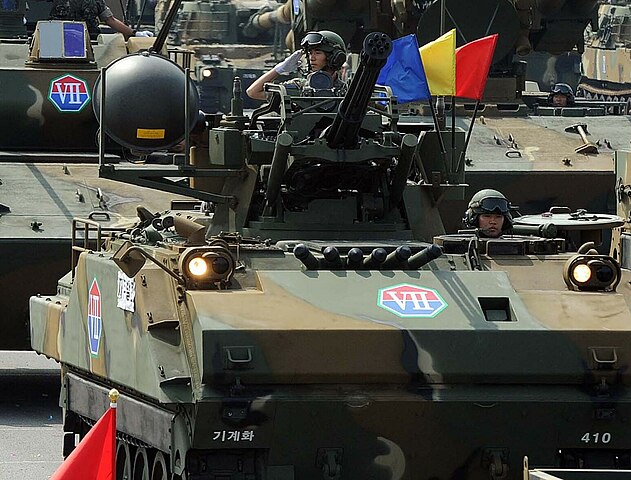
K263A1 Chunging, replaced by the K30. 2013, 65th Anniversary of the ROK armed Forces
In its role it is focusing on major weapons platforms, in high-risk and non-economical fields. Later to be passed onto private-owned industries for the final production. It was at the origin of 15 missiles or rocket systems, five infantry weapons, five missile defence systems twelve heavy weapons systems, maritime WS, aircraft, UAVs and ground vehicles.
The final prototype of the K30 started to run in 1991, but there was still a long process of testings and modifications to go from this to the final production vehicle, greenlighted in 1996. Tong-il Heavy Industries partnered with Hanwha Aerospace, the first for the platform, the second for the main guns and MANPADS, radars and fire control systems. It was developed in parallel to the K-SAM Chunma, the crotale-derived missiles system.
By September 2001, production of enhanced prototypes led to the integration into Doosan Infracore, as part of a major contract in the 2007 Acquisition Program with a new order in 2002 worth W500 billion (US$543 million) for deliveries in 2008. Production so far has been 176 vehicles at a unit cost of 13,3 billion KRW (12.1 million USD).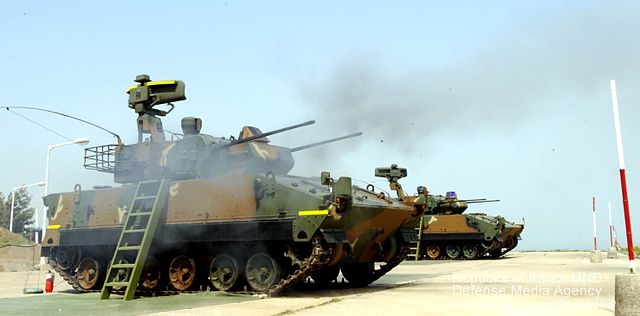
2011 K30 Biho
The cannons are capable of a cyclic 600 rpm and 3,000 m (1.9 mi) range, each being loaded with 300 rounds.
Ballistic computation data is then provided to the onboard digital fire-control system via the electro-optical targeting system which lays the 30 mm guns to their correct azimuth and elevation in real time, without human input. This automation at the speed of wiring enables accurate fire on the move and against fst moving targets, in all weather. The radar is a indepdenent unit, easy to replace or installed on a truck, typically South Korean 5-ton six-wheeled vehicle as well as a self-towed generator unit to create an independent surveillance platform. The secondary FLIR system plus its associated laser rangefinder provides the TPS-830K radar with additional targeting data in case it is inoperative or turned off. For aircraft having radar warning receivers this could cause a surprise.
hanwha-defense.co.kr
SNT Dtnamics
[Defense Zoom Talk Show] Story of Hybrid Biho in India
DX Korea 2018: Upgraded Biho 30mm-missiles air defense vehicle in service with ROK army
ADEX 2015: Doosan develops dynamic duo
South Korea to Field Hybrid Version of the BiHO VSHORAD Vehicle in 2015
New Hybrid BIHO SHORAD 30mm manpads air defense armoured at AUSA 2017
armyrecognition.com/ K30 trials
On the K30 Chunho (in Korean)
asiatoday.co.kr
south korean sale k-30 biho threatened
globalsecurity.org
defense.doosaninfracore.co.kr
The K30 was proposed for a bid by India, looking for a new SPAAG system in 2015. Tests were conducted until 2017. It was accepted as announced by HDS with reports of an unnamed competitor interfering via pro-Russian personal and alleged "bias" in the selection process. The system was shortlisted indeed after a first competition round against the Tunguska-M1 and Pantsir-S1 proposed by Russia. This was called the Self Propelled Air Defence Gun Missile System (SPAD-GMS) program with 104 unit to be ordered. This ws conformed by May 2019 for $2.6 billion until cancelled in September 2020 for the ongoing development of the Atmanirbhar Bharat. Later Doosan tried to market a "Hybrid Biho" for a possible order as an "Anti-Drone system" as part of the required platforms for the SPAD-GMS program.
The South Korean SPAAG
The K30 was announced as far back as 1983 as part of a two-vehicles, single platform utility tracked vehicle, the chassis being able to support both a SPAAG (guns) and SPAAML (missiles) for cost efficience. Some 600 personnel started a long R&D process by the Agency for Defense Development at a cost of 10 billion. The state-owned agency (Gukbang Gwahak Yeonguso) is the dedicated defence R&D organism of South Korea, originated in the August 1970 self-reliant national defense policy by President Park Chung Hee.
K263A1 Chunging, replaced by the K30. 2013, 65th Anniversary of the ROK armed Forces
In its role it is focusing on major weapons platforms, in high-risk and non-economical fields. Later to be passed onto private-owned industries for the final production. It was at the origin of 15 missiles or rocket systems, five infantry weapons, five missile defence systems twelve heavy weapons systems, maritime WS, aircraft, UAVs and ground vehicles.
The final prototype of the K30 started to run in 1991, but there was still a long process of testings and modifications to go from this to the final production vehicle, greenlighted in 1996. Tong-il Heavy Industries partnered with Hanwha Aerospace, the first for the platform, the second for the main guns and MANPADS, radars and fire control systems. It was developed in parallel to the K-SAM Chunma, the crotale-derived missiles system.
By September 2001, production of enhanced prototypes led to the integration into Doosan Infracore, as part of a major contract in the 2007 Acquisition Program with a new order in 2002 worth W500 billion (US$543 million) for deliveries in 2008. Production so far has been 176 vehicles at a unit cost of 13,3 billion KRW (12.1 million USD).
Design
Hull, Layout and Protection
The K30 shares the same chassis as the K-SAM Chunma but adapted, both derived from the K200 infantry fighting vehicle chassis with some differences. The general hull is boxy, with a two-piece angular nose, higher angle upper plate for extra protection over the transmission. The front-mounted power unit directly participated on the crew's frontal protection.Power unit and performances
The chassis has an extra roadwheel drivetrain, and is powered by a front-mounted Doosan D2840L engine, replacing the D2848T on the K200. This new power unit boosts the output from 350 to 520 horsepower, as the K30 is much heavier than the K200. This MAN-Doosan D2840L 520 hp (388 kw) multifuel diesel engine boasts a power to weight ratio of 20.8 hp/ton. It was originally coupled with an Allison Transmission's X200-5K (K200), but replaced in production by the home-grown S&T Dynamics HMPT500-3EK/4EK transmission, better adapted ti the massive torque of the new power unit. This chassis offers limited amphibious capability (not buoyant, only fording capable). The six ruberrized, doubles roadwheels are completed by three return rollers, forward drive spockets and rear idlers.Armament

2011 K30 Biho
The original Gun system
The K30 Biho consisted of the following: -Twin 30 mm guns -TPS-830K surveillance and fire-control radar -Electro-optical targeting system -Main Panoramic periscope -Forward looking infrared system (FLIR) -Laser rangefinder (LRF) -Thermal sight with 10x magnification -TV camera -Digital fire-control computer and displays. Targeting range is over 10 km (6.2 mi) while the TPS-830K radar is able to scan 22 sq ft of area, the RCS target can range up to 17 km (11 mi).The cannons are capable of a cyclic 600 rpm and 3,000 m (1.9 mi) range, each being loaded with 300 rounds.
The Shinghung SAM system
By December 2013, the Shingung surface-to-air missile addition was aimed at increasing the hitting range to 7 km. The main mount received two rotating pods, each containing two missiles mounted in tandem on either side. This integration was completed in 2014. From October 2015 full-rate conversion of earlier vehicles and production for this upgraded vehicle started, and the modernized K30 Biho combining both systems entered service by late 2018.The Targeting System
The TPS-830K radar is an X-band model (8 to 12.5 GHz) tasked of surveillance and fire-control. It is a pulse-Doppler radar optimized to catch and track low-flying aircraft and helicopter. It provided the crew with real-time early warning and well as a management of multiple target detection in integral L-band (1 to 2 GHz), as well as IFF (Identification Friend or Foe). It is also capable of pulse compression and frequency agility, and the tracking can provides accurate moving target indication. It could also be used despite chaff.Ballistic computation data is then provided to the onboard digital fire-control system via the electro-optical targeting system which lays the 30 mm guns to their correct azimuth and elevation in real time, without human input. This automation at the speed of wiring enables accurate fire on the move and against fst moving targets, in all weather. The radar is a indepdenent unit, easy to replace or installed on a truck, typically South Korean 5-ton six-wheeled vehicle as well as a self-towed generator unit to create an independent surveillance platform. The secondary FLIR system plus its associated laser rangefinder provides the TPS-830K radar with additional targeting data in case it is inoperative or turned off. For aircraft having radar warning receivers this could cause a surprise.
Links, sources
man.fas.orghanwha-defense.co.kr
SNT Dtnamics
[Defense Zoom Talk Show] Story of Hybrid Biho in India
DX Korea 2018: Upgraded Biho 30mm-missiles air defense vehicle in service with ROK army
ADEX 2015: Doosan develops dynamic duo
South Korea to Field Hybrid Version of the BiHO VSHORAD Vehicle in 2015
New Hybrid BIHO SHORAD 30mm manpads air defense armoured at AUSA 2017
armyrecognition.com/ K30 trials
On the K30 Chunho (in Korean)
asiatoday.co.kr
south korean sale k-30 biho threatened
globalsecurity.org
defense.doosaninfracore.co.kr
K-30 specifications | |
| Dimensions | 6.77 x 3 x 4.05 m (22.2 x 9.84 x 13.3 ft radar on) |
| Total weight, battle ready | |
| Crew | 3 (driver, cdr, operator) |
| Propulsion | MAN-Doosan D2840L 10V TID 520hp (388 kW) |
| Suspension | Torsion bars, shock dampers |
| Speed (road) | 65 km/h (40 mph) |
| Range | 500 km (310 mi) |
| Armament | S&T Dynamics dual KKCB 30 mm, Shingung MANPADS |
| Armor | Estimated 25 mm frontal arc, 8-13 mm sides rear top (0.3-0.9 in) |
| Total production | 176 in 2009 |
Service, upgrades and exports
From 1996 in small numbers due to the slow delivery pace, the K30 Biho started to replace the sixty ageing M263 VADS using the M167 Vulcan based M113 system. The contract is likely "completed" in 2012 and all armoured units received organic platoons of such vehicles alongside the K-SAM Chunma. The K30 never was deployed abroad so far and thus never fired in anger yet. More recently, hyundai Rotem announced a variant of the K808/806 White Tiger 8x8 vehicle for organic SPAAG capability. The 2016 vehicle is indeed much faster at 110 kph on flat. This 2021 wheeled was presented as the "Sky Tiger" of K30 Chunho anti-aircraft gun wheeled vehicle system (AAGW). It passed all tests and was recently greenblighted to enter service with the Republic of Korea Army. It features a lighter K30 turret.The K30 was proposed for a bid by India, looking for a new SPAAG system in 2015. Tests were conducted until 2017. It was accepted as announced by HDS with reports of an unnamed competitor interfering via pro-Russian personal and alleged "bias" in the selection process. The system was shortlisted indeed after a first competition round against the Tunguska-M1 and Pantsir-S1 proposed by Russia. This was called the Self Propelled Air Defence Gun Missile System (SPAD-GMS) program with 104 unit to be ordered. This ws conformed by May 2019 for $2.6 billion until cancelled in September 2020 for the ongoing development of the Atmanirbhar Bharat. Later Doosan tried to market a "Hybrid Biho" for a possible order as an "Anti-Drone system" as part of the required platforms for the SPAD-GMS program.
Gallery
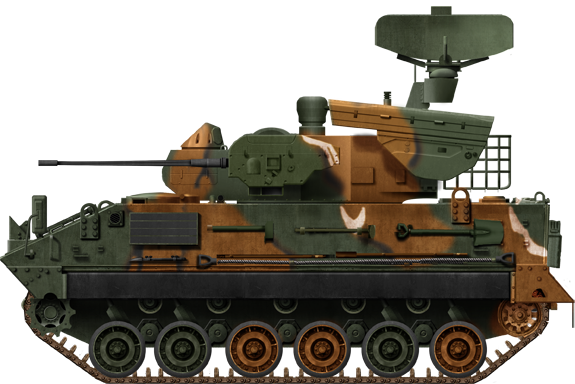
Author's rendition of the upgraded vehicle, from 2016 onwards.
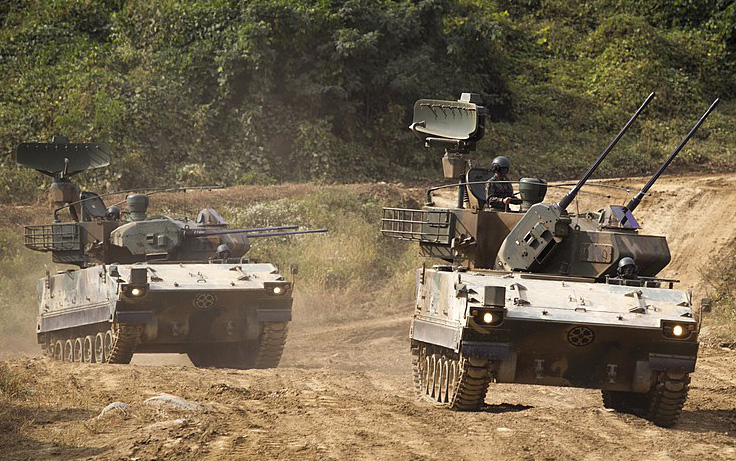
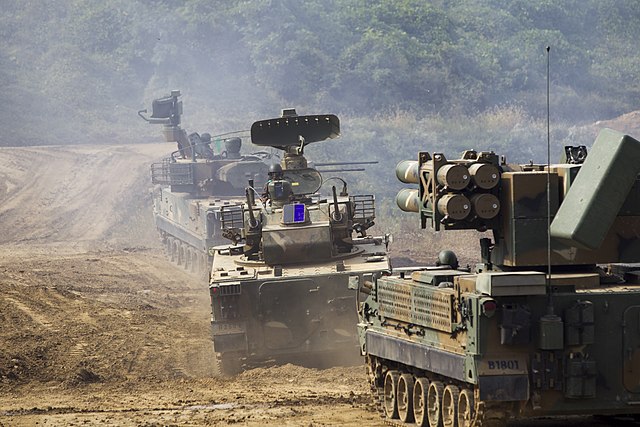
K30 Biho in the 2014 manoeuvers
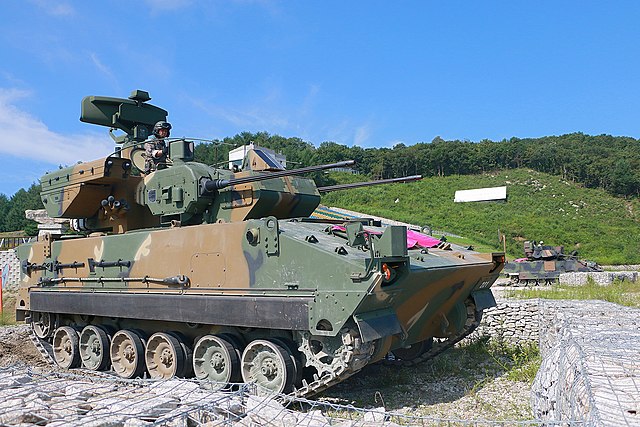
K30 and Bradley at the firing range
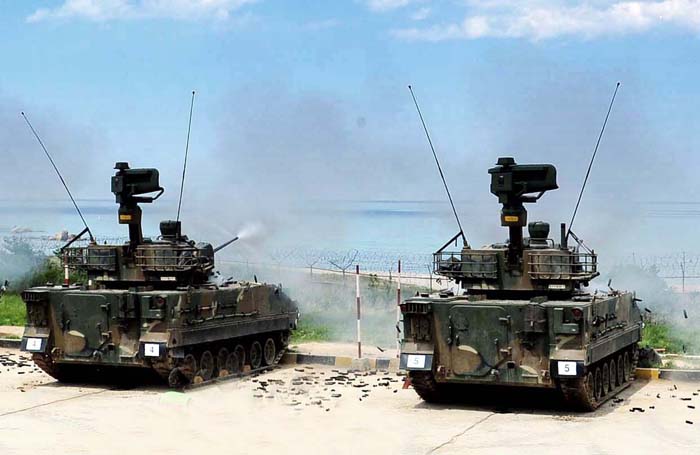
K30s of the 11th Division in coastal fire training
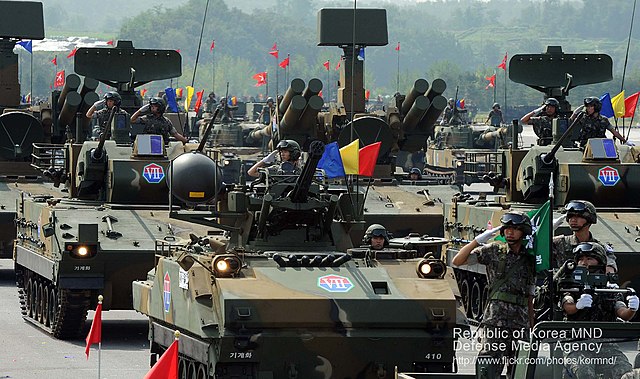
K30 at the 65th anniversary of the ROK Army
2007, Seoul Air Show

Modern Tanks
Modern MBTs posters

Denel Bagder (2018)

Type 16 MCV (2016)

Gepard 1A2 last rounds 2011

SANDF

Russian AFVs

Main Battle Tanks
